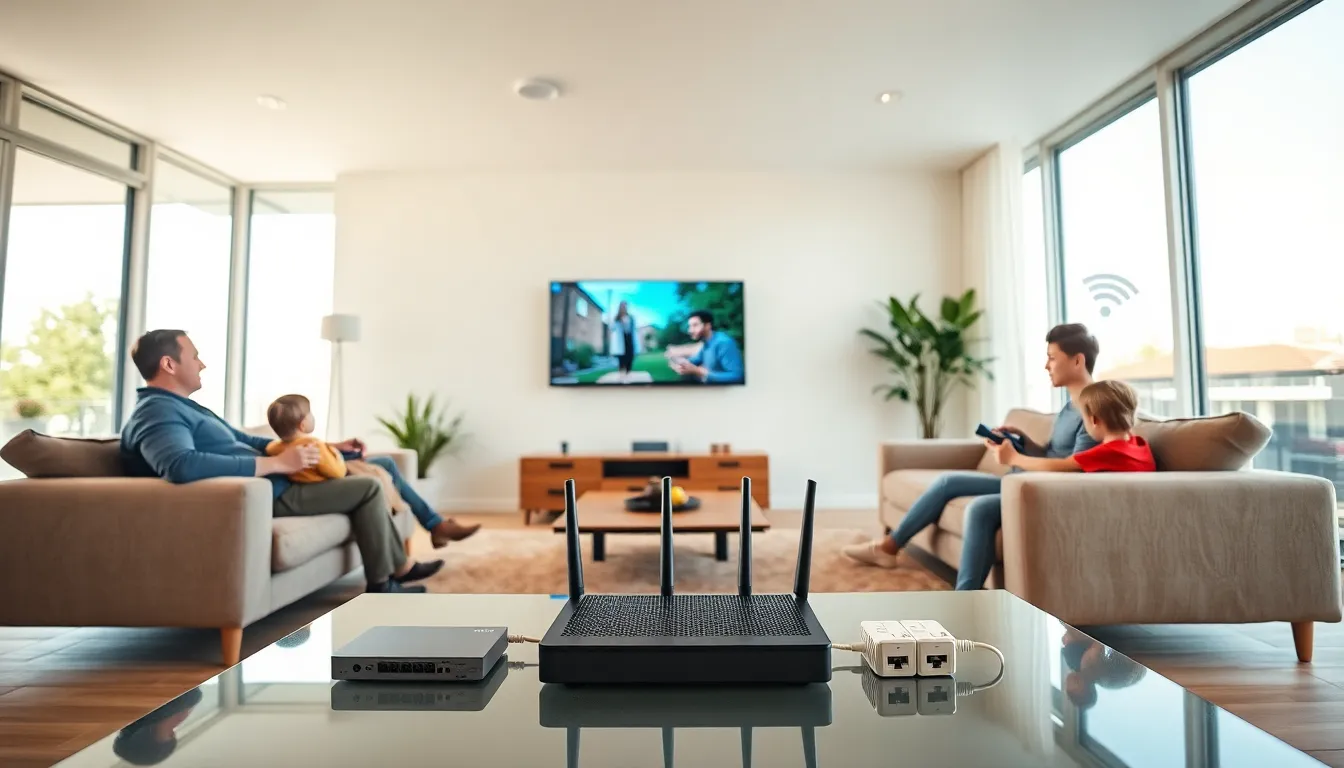In a world increasingly defined by connectivity, home networking services have emerged as the unsung heroes of modern living. Think of them as the invisible backbone of your household, while we often take Wi-Fi for granted, a robust network can make a world of difference. From streaming movies in crisp 4K to video chatting with grandma, a reliable home network is essential. But what’s the secret sauce behind these services? Let’s jump into the essential elements that make up the realm of home networking, mixing informative insights with a dash of humor.
Table of Contents
ToggleUnderstanding Home Networking

At its core, home networking is about connecting devices within one household to enable communication and resource sharing. Picture a bustling family: Grandma is streaming a documentary, Dad is working from home, and the kids are battling it out on some high-stakes online game. It sounds chaotic, but thanks to home networking, this is all possible without any hiccups. A solid home network ensures that these devices can coexist and function smoothly, like a well-choreographed dance.
In essence, home networking consists of various technologies that allow devices to communicate with each other, usually via the internet. This network not only connects laptops and desktops but also smartphones, tablets, smart TVs, gaming consoles, and even smart home devices.
Understanding the fundamentals of how a home network operates is essential. Most homes use a router, which acts as the traffic cop, directing data between connected devices and the internet. Every time a device requests a webpage or streams a video, the router makes sure that data flows efficiently. Troubles arise when the network settings aren’t correctly configured or when equipment fails to meet the demands of a household, which can turn connectivity bliss into a living nightmare.
Types of Home Networking Services
Home networking services primarily fall into two categories: wireless and wired. Let’s break those down.
Wireless Networking Solutions
Wireless networking services are all about convenience. Imagine browsing the web on your patio without being tethered to an outlet, pure bliss. Wi-Fi is the quintessential example of a wireless network. It allows multiple devices to connect without cabling clutter, offering flexibility in where they can be used.
But, it’s not all rainbows and sunshine. Wireless networks can suffer from signal interference, especially in larger homes with walls, appliances, and other barriers. Strengthening a wireless network often involves strategically placing extenders or upgrading to a mesh network system, which distributes signals evenly across the space.
Wired Networking Options
For those who prioritize speed and reliability, wired networking might be the way to go. Ethernet cables connect devices directly to the router, providing faster data transfer rates and more robust connections than Wi-Fi. This setup is especially beneficial for gaming or streaming high-definition content, where every millisecond counts.
Although wired options require running cables, often inconvenient, they ensure that individuals can enjoy uninterrupted service without the interference wireless networks sometimes face. So, a perfect blend of both wired and wireless solutions often emerges as the best choice for many households.
Choosing the Right Equipment
Selecting the right equipment can feel overwhelming, especially with the plethora of options on the market. So, what should one look for?
First, consider bandwidth and speed. Internet speed is typically measured in megabits per second (Mbps), and for a modern household, speeds of at least 100 Mbps are ideal. But, if multiple devices are connected simultaneously, higher speeds may be necessary.
Next, think about the router. A dual-band router can transmit on two frequencies, either 2.4 GHz or 5 GHz. The 2.4 GHz band covers wider areas but at slower speeds, while the 5 GHz band is faster but has a shorter range. For larger homes, a tri-band router can offer even greater flexibility. Also, Wi-Fi 6 technology is the latest standard, promising increased efficiency, speed, and capacity, which is worth considering.
Finally, potential buyers should also invest in good quality Ethernet cables, as not all cables are created equal. Higher-quality cables will ensure better performance where wired connections are used.
Installation and Setup Services
Setting up a home network isn’t as straightforward as plugging in a few devices. Factors like layout, materials of walls, and types of devices involved can complicate matters.
Many companies provide comprehensive installation and setup services. A professional installer assesses the home environment and identifies ideal placements for routers, extenders, or switches to maximize coverage and minimize dead zones. By integrating their expertise with your needs, they can create a seamless networking experience.
Besides, ensuring that security measures are effectively implemented is another priority. Nobody wants an unwelcome guest on their network, so setting up robust passwords, enabling firewalls, and regularly updating firmware are steps that should never be overlooked.
Troubleshooting and Support Services
Once a network is established, issues can still arise. We’ve all been there: connectivity drops just when you’re about to binge the latest series or while you’re diving into an important video meeting. This is where troubleshooting and support services come into play.
Many service providers offer dedicated support to assist customers when they encounter problems. Whether it’s a slow connection, Wi-Fi dead zones, or sporadic outages, these services typically provide diagnostic tools to identify and fix issues remotely, saving users the hassle of dealing with complicated setups.
Some may also offer on-site support for those who prefer personal assistance or when problems require physical intervention. A quick call to a support line can often put an end to your networking woes.
Future Trends in Home Networking
As technology continues to evolve, so does the landscape of home networking services. One noticeable trend is the expansion of smart home ecosystems. Devices like smart speakers, security cameras, and smart thermostats are rapidly integrating, which calls for a network capable of handling multiple connections without lag.
Another emerging trend is the rollout of Wi-Fi 6 and the anticipated Wi-Fi 7. These advancements promise faster speeds, reduced latency, and improved security, effectively raising the baseline expectations for home networks in the coming years.
Also, 5G technology is gradually becoming a viable alternative to traditional internet services, potentially transforming how homes access the internet altogether.
As we move forward, understanding these emerging trends will be crucial for homeowners wanting to maximize their connectivity.





